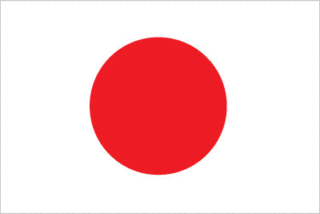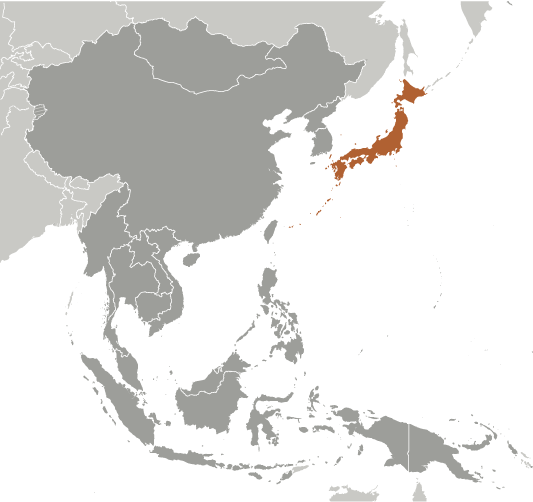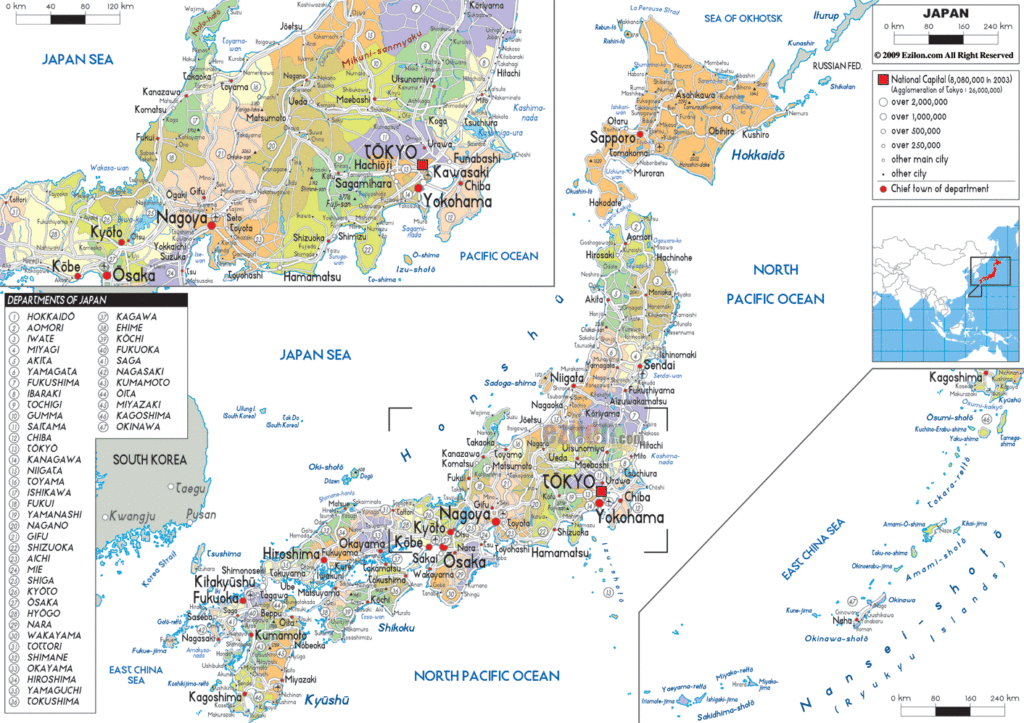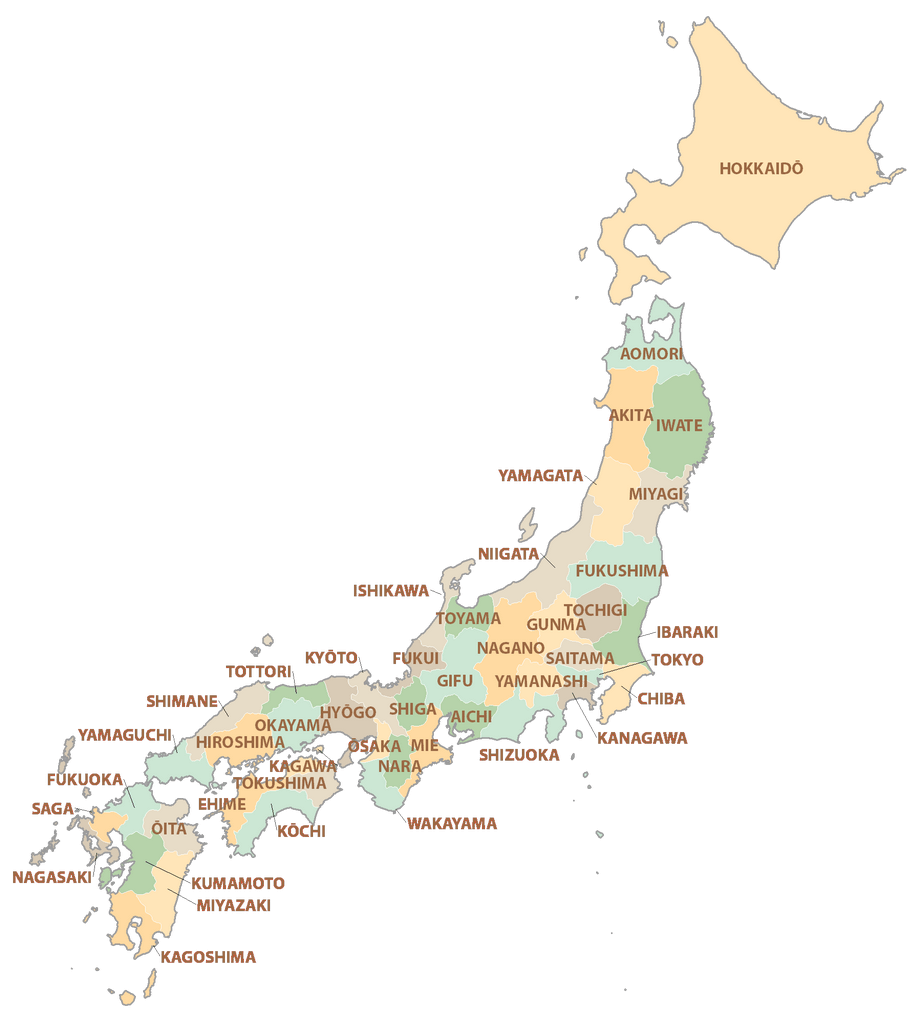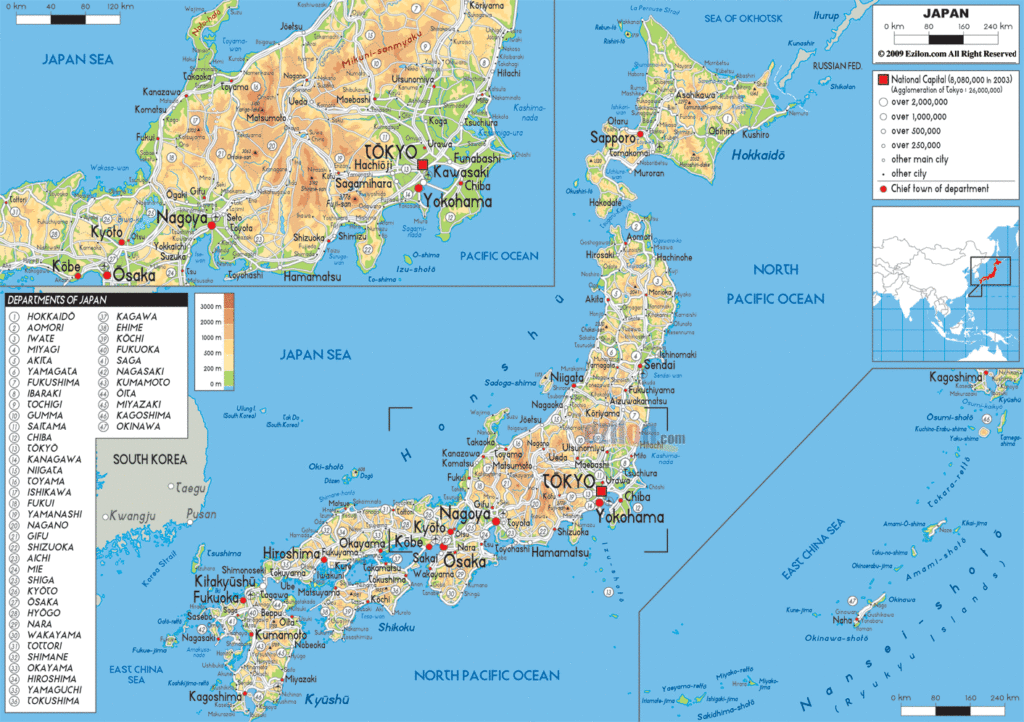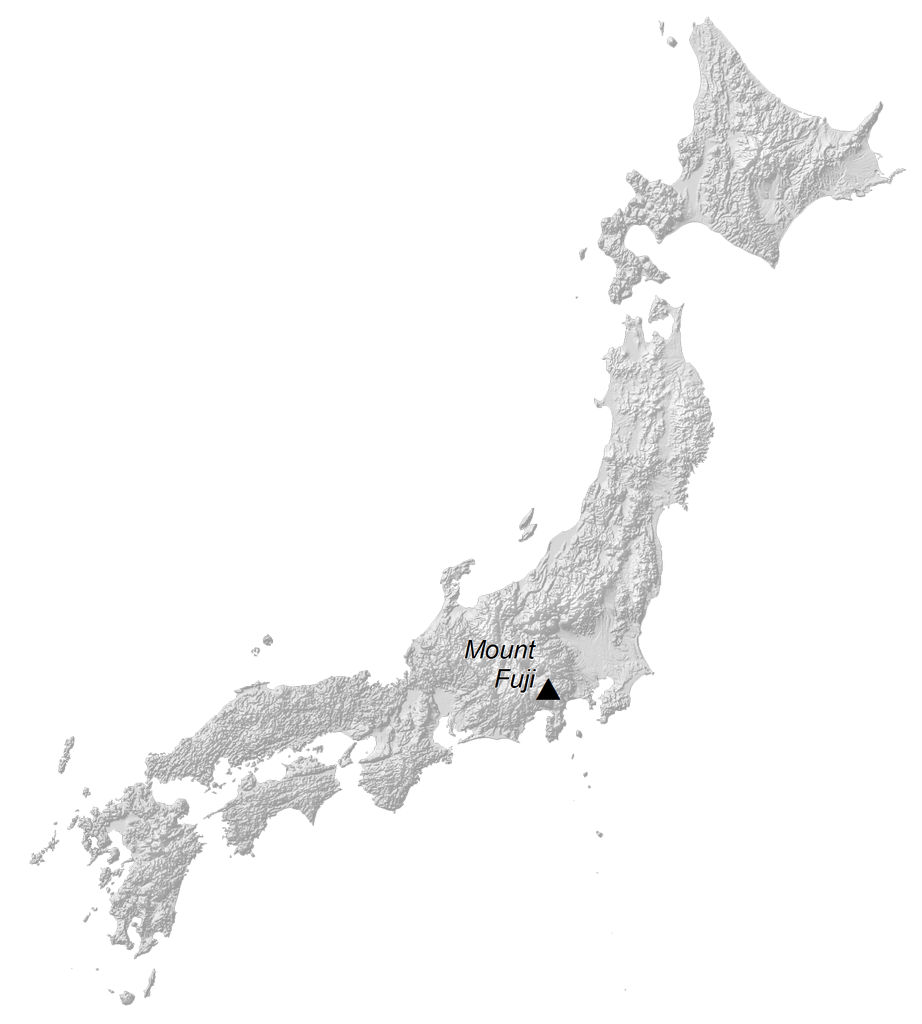The archipelago of Japan contains over 4,000 islands stretching along the Pacific coast of East Asia, with four major islands (sometimes referred to as the “Home Islands”): Hokkaido, Honshu, Kyushu and Shikoku. These four islands can be seen on the physical map of the country above.
Honshu is the main island of Japan, and largest at 810 miles (1,300 km) in length. Dominated by mountains and volcanoes, the massive earthquake of March 2011 moved Honshu 7.9 ft (2.4 m).
The second largest, Hokkaido, is also the northernmost of Japan’s islands; while on the other end, Kyushu is the most southwesterly. Shikoku is the smallest and least populous of the four main islands.
A long ridge of rugged mountains runs through the heart of Japan, punctuated by steep tree-lined slopes, and deep valleys on the Pacific Ocean side, and lower hills and mountains along the Sea of Japan side.
The main interior mountain ranges include the Akaishi, Hido and Kiso, where elevations typically exceed 9,800 ft. (3,000 m). The country’s highest point, Mt. Fuji, southwest of Tokyo, is a dormant volcano that rises 12,388 ft. (3,776 m). Its position has been marked on the map.
The islands of Japan are located on the Ring of Fire, and as a result suffer from frequent, violent earthquakes and some serious volcanic activity. There are a total of 108 active volcanoes within Japan’s archipelago, most of which provoke devastating earthquakes and tsunamis several times every century.
A small series of plains are situated along the coastal areas. A notable number of (very short) rivers flow briskly down the mountains into the coastal areas. The largest river in Japan is the Shinano.
Explore Japan with this detailed map of its major cities, highways and islands. Get a birds-eye view of its mountainous terrain and imagery with the satellite and elevation map. Discover the beauty of Japan as you take a virtual tour through its cities, highways, and islands.
Online Interactive Political Map
Click on ![]() to view map in "full screen" mode.
to view map in "full screen" mode.
Japan is divided into 47 prefectures. In alphabetical order, these prefectures are – Aichi, Akita, Aomori, Chiba, Ehime, Fukui, Fukuoka, Fukushima, Gifu, Gunma, Hiroshima, Hokkaido, Hyogo, Ibaraki, Ishikawa, Iwate, Kagawa, Kagoshima, Kanagawa, Kochi, Kumamoto, Kyoto, Mie, Miyagi, Miyazaki, Nagano, Nagasaki, Nara, Nilgata, Oita, Okayama, Okinawa, Osaka, Saga, Saitama, Shiga, Shimane, Shizuoka, Tochigi, Tokushima, Tokyo, Tottori, Toyama, Wakayama, Yamagata, Yamaguchi and Yamanashi. These are further divided into sub prefectures and smaller subdivisions.
Located at the northwest of Tokyo Bay on the Pacific coast of central Honshu Islands – is Tokyo, the capital and largest city of Japan. The Greater Tokyo Area is the largest, most populous, urbanized metropolitan area in Japan as well as in the entire world. Tokyo also forms the largest economic, industrial and commercial center of Japan, apart from being the country’s administrative center.
Location Maps
Where is Japan?
Japan is an archipelago of over 6,800 islands located in Eastern Asia in the North Pacific Ocean. Of these, four main islands stand out – Honshu, Kyushu, Hokkaido, and Shikoku. Honshu is home to major cities like Tokyo (Japan’s capital and largest city), Yokohama, Osaka, Kyoto, and Kobe. Kyushu is the southwesternmost main island situated near the Korean Peninsula. Hokkaido is the northernmost main island known for its colder climate. Shikoku is the smallest of the four main islands and is separated by the Inner Sea from the rest of Japan. Some consider Okinawa as the fifth main island, which has a more tropical climate.
High Definition Political Map of Japan

Japan Administrative Map
History
Prehistoric to classical history
A Paleolithic culture from around 30,000 BC constitutes the first known habitation of the islands of Japan. This was followed from around 14,500 BC (the start of the Jōmon period) by a Mesolithic to Neolithic semi-sedentary hunter-gatherer culture characterized by pit dwelling and rudimentary agriculture. Clay vessels from the period are among the oldest surviving examples of pottery. From around 700 BC, the Japonic-speaking Yayoi people began to enter the archipelago from the Korean Peninsula, intermingling with the Jōmon; the Yayoi period saw the introduction of practices including wet-rice farming, a new style of pottery, and metallurgy from China and Korea. According to legend, Emperor Jimmu (grandson of Amaterasu) founded a kingdom in central Japan in 660 BC, beginning a continuous imperial line.
Japan first appears in written history in the Chinese Book of Han, completed in 111 AD. Buddhism was introduced to Japan from Baekje (a Korean kingdom) in 552, but the development of Japanese Buddhism was primarily influenced by China. Despite early resistance, Buddhism was promoted by the ruling class, including figures like Prince Shōtoku, and gained widespread acceptance beginning in the Asuka period (592–710).
The far-reaching Taika Reforms in 645 nationalized all land in Japan, to be distributed equally among cultivators, and ordered the compilation of a household registry as the basis for a new system of taxation. The Jinshin War of 672, a bloody conflict between Prince Ōama and his nephew Prince Ōtomo, became a major catalyst for further administrative reforms. These reforms culminated with the promulgation of the Taihō Code, which consolidated existing statutes and established the structure of the central and subordinate local governments. These legal reforms created the ritsuryō state, a system of Chinese-style centralized government that remained in place for half a millennium.
The Nara period (710–784) marked the emergence of a Japanese state centered on the Imperial Court in Heijō-kyō (modern Nara). The period is characterized by the appearance of a nascent literary culture with the completion of the Kojiki (712) and Nihon Shoki (720), as well as the development of Buddhist-inspired artwork and architecture. A smallpox epidemic in 735–737 is believed to have killed as much as one-third of Japan’s population. In 784, Emperor Kanmu moved the capital, settling on Heian-kyō (modern-day Kyoto) in 794. This marked the beginning of the Heian period (794–1185), during which a distinctly indigenous Japanese culture emerged. Murasaki Shikibu’s The Tale of Genji and the lyrics of Japan’s national anthem “Kimigayo” were written during this time.
Feudal era
Japan’s feudal era was characterized by the emergence and dominance of a ruling class of warriors, the samurai. In 1185, following the defeat of the Taira clan in the Genpei War, samurai Minamoto no Yoritomo established a military government at Kamakura. After Yoritomo’s death, the Hōjō clan came to power as regents for the shōgun. The Zen school of Buddhism was introduced from China in the Kamakura period (1185–1333) and became popular among the samurai class. The Kamakura shogunate repelled Mongol invasions in 1274 and 1281 but was eventually overthrown by Emperor Go-Daigo. Go-Daigo was defeated by Ashikaga Takauji in 1336, beginning the Muromachi period (1336–1573). The succeeding Ashikaga shogunate failed to control the feudal warlords (daimyō) and a civil war began in 1467, opening the century-long Sengoku period (“Warring States”).
During the 16th century, Portuguese traders and Jesuit missionaries reached Japan for the first time, initiating direct commercial and cultural exchange between Japan and the West. Oda Nobunaga used European technology and firearms to conquer many other daimyō; his consolidation of power began what was known as the Azuchi–Momoyama period. After the death of Nobunaga in 1582, his successor, Toyotomi Hideyoshi, unified the nation in the early 1590s and launched two unsuccessful invasions of Korea in 1592 and 1597.
Tokugawa Ieyasu served as regent for Hideyoshi’s son Toyotomi Hideyori and used his position to gain political and military support. When open war broke out, Ieyasu defeated rival clans in the Battle of Sekigahara in 1600. He was appointed shōgun by Emperor Go-Yōzei in 1603 and established the Tokugawa shogunate at Edo (modern Tokyo). The shogunate enacted measures including buke shohatto, as a code of conduct to control the autonomous daimyō, and in 1639 the isolationist sakoku (“closed country”) policy that spanned the two and a half centuries of tenuous political unity known as the Edo period (1603–1868). Modern Japan’s economic growth began in this period, resulting in roads and water transportation routes, as well as financial instruments such as futures contracts, banking and insurance of the Osaka rice brokers. The study of Western sciences (rangaku) continued through contact with the Dutch enclave in Nagasaki. The Edo period gave rise to kokugaku (“national studies”), the study of Japan by the Japanese.
Modern era
The United States Navy sent Commodore Matthew C. Perry to force the opening of Japan to the outside world. Arriving at Uraga with four “Black Ships” in July 1853, the Perry Expedition resulted in the March 1854 Convention of Kanagawa. Subsequent similar treaties with other Western countries brought economic and political crises. The resignation of the shōgun led to the Boshin War and the establishment of a centralized state nominally unified under the emperor (the Meiji Restoration). Adopting Western political, judicial, and military institutions, the Cabinet organized the Privy Council, introduced the Meiji Constitution (November 29, 1890), and assembled the Imperial Diet. During the Meiji period (1868–1912), the Empire of Japan emerged as the most developed nation in Asia and as an industrialized world power that pursued military conflict to expand its sphere of influence. After victories in the First Sino-Japanese War (1894–1895) and the Russo-Japanese War (1904–1905), Japan gained control of Taiwan, Korea and the southern half of Sakhalin. The Japanese population doubled from 35 million in 1873 to 70 million by 1935, with a significant shift to urbanization.
The early 20th century saw a period of Taishō democracy (1912–1926) overshadowed by increasing expansionism and militarization. World War I allowed Japan, which joined the side of the victorious Allies, to capture German possessions in the Pacific and in China. The 1920s saw a political shift towards statism, a period of lawlessness following the 1923 Great Tokyo Earthquake, the passing of laws against political dissent, and a series of attempted coups. This process accelerated during the 1930s, spawning several radical nationalist groups that shared a hostility to liberal democracy and a dedication to expansion in Asia. In 1931, Japan invaded and occupied Manchuria; following international condemnation of the occupation, it resigned from the League of Nations two years later. In 1936, Japan signed the Anti-Comintern Pact with Nazi Germany; the 1940 Tripartite Pact made it one of the Axis Powers.
The Empire of Japan invaded other parts of China in 1937, precipitating the Second Sino-Japanese War (1937–1945). In 1940, the Empire invaded French Indochina, after which the United States placed an oil embargo on Japan. On December 7–8, 1941, Japanese forces carried out surprise attacks on Pearl Harbor, as well as on British forces in Malaya, Singapore, and Hong Kong, among others, beginning World War II in the Pacific. Throughout areas occupied by Japan during the war, numerous abuses were committed against local inhabitants, with many forced into sexual slavery. After Allied victories during the next four years, which culminated in the Soviet invasion of Manchuria and the atomic bombings of Hiroshima and Nagasaki in 1945, Japan agreed to an unconditional surrender. The war cost Japan its colonies and millions of lives. The Allies (led by the United States) repatriated millions of Japanese settlers from their former colonies and military camps throughout Asia, largely eliminating the Japanese Empire and its influence over the territories it conquered. The Allies convened the International Military Tribunal for the Far East to prosecute Japanese leaders for war crimes.
In 1947, Japan adopted a new constitution emphasizing liberal democratic practices. The Allied occupation ended with the Treaty of San Francisco in 1952, and Japan was granted membership in the United Nations in 1956. A period of record growth propelled Japan to become the second-largest economy in the world; this ended in the mid-1990s after the popping of an asset price bubble, beginning the “Lost Decade”. On March 11, 2011, Japan suffered one of the largest earthquakes in its recorded history, triggering the Fukushima Daiichi nuclear disaster. On May 1, 2019, after the historic abdication of Emperor Akihito, his son Naruhito became Emperor, beginning the Reiwa era.
Physical Map of Japan

